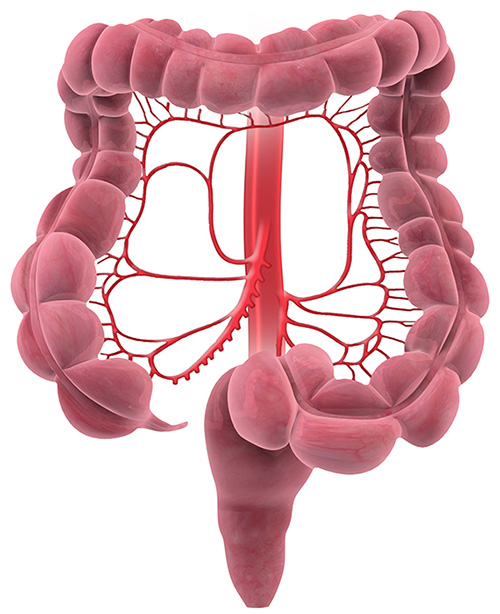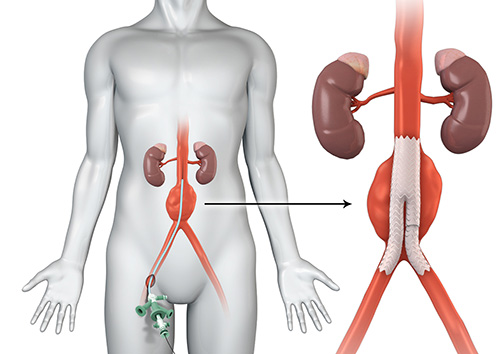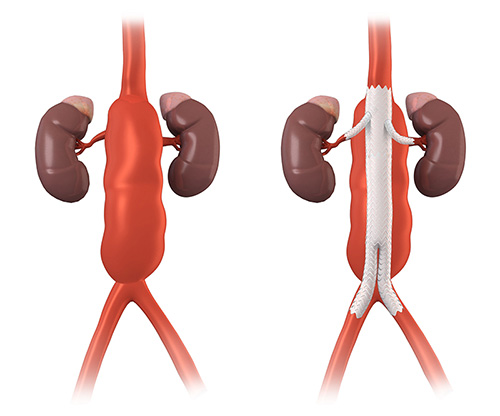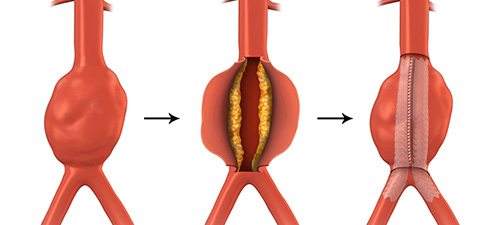Mesenteric Artery Aneurysm
What is a Mesenteric Artery Aneurysm?
An aneurysm is a condition where the walls of a blood vessel weaken. Over a period of time, the pressure of the blood flowing through the vessel causes it to expand or bulge at the point of weakness.

A mesenteric artery aneurysm is an aneurysm that occurs in either the inferior or superior mesenteric arteries that carry oxygen rich blood to the gastrointestinal tract (stomach, intestines, colon and rectum).
An aneurysm can develop in any blood vessels (arterial or venous) in the body. Other common vessels that an aneurysm occurs in are:
What causes a Mesenteric Artery Aneurysm?
The cause of aneurysm is not known, but there are numerous risk factors that include:
- Family history
- Being male
- Being over 65
- A history of smoking
- High blood pressure
- High cholesterol
- Atherosclerosis (hardened arteries)
- Having a connective tissue disorder like Marfans or Ehlers-Danlos syndrome
If you are known to have, or if you are likely to develop an aneurysm disease, it is recommended that you optimise your lifestyle by:
- Controlling high blood pressure
- Controlling cholesterol
- Ceasing smoking
- Exercising regularly
What are the signs/symptoms of a Mesenteric Artery Aneurysm?
Sometimes there are no symptoms. However, if the aneurysm does become symptomatic, the signs can include:
- Severe abdominal pain after eating
- Weight loss
- Nausea and vomiting
- Bloody bowel movements
- Constipation or diarrhea
The following symptoms could mean that the MAA is expanding quickly and may rupture. You must go directly for emergency department if you experience them:
- Sudden, intense and persistent abdominal or back pain, which can be described as a tearing sensation
- Pain that radiates to your back or legs
- Sweatiness
- Clamminess
- Dizziness
- Nausea
- Vomiting
- Low blood pressure
- Fast pulse
How will a Mesenteric Aortic Aneurysm affect my health?
The effects of an Aneurysm on your health is dependent on the type of aneurysm, how quickly it develops and how likely it is to rupture.
Mesenteric aneurysms in particular are uncommon but can be lethal if not treated immediately.
The worst effects of a Mesenteric Aortic Aneurysm are life-threatening complications from a rupture, such as internal bleeding and clots. More easily manageable, or smaller aneurysms simply need lifestyle changes, a watchful eye and regular checkups with the doctor.
What are the stages of a Mesenteric Artery Aneurysm?
- First off, a local weakening of the mesenteric arterial walls creates an unstable area where an aneurysm can occur.
- A MAA occurs, bulging the wall of the artery. Many start small and stay small, although they sometimes expand over time.
- Sometimes there are no symptoms of the MAA.
- However, if the aneurysm does become symptomatic, the signs can include:
- A constant, deep pain in your abdomen.
- A pulsing sensation in your gut, or at the location of the aneurysm.
- Back pain
- Chest pain
- Conservative management, scanning and diagnosis/risk assessment is made.
- Surgery will follow if MAA is large enough.
I think I have a Mesenteric Artery Aneurysm – What should I do?
If you think you are at risk of having an aneurysm OR have a family history of aneurysm you should:
- See your GP: If you are in a high risk group, experiencing some pain, or if you are visiting your GP for routine reasons, get a check for MAA with your GP. They may find evidence of an MAA as some can be felt during an abdominal examination. In some instances, patients have been sent for tests for something else and those tests identify the MAA, so if you are concerned, please investigate your health with a GP first. If evidence presents of an MAA, your GP will almost always send you onto a Vascular Surgeon.
- See a Vascular Surgeon: Our surgeons at Sydney Vascular Surgery will likely send you for tests to determine the size and shape (morphology) of your MAA.
Your surgeon will take a detailed history and perform a physical examination, which will include listening to your heart, examining your abdomen and assessing the pulses in your neck, arms and legs both by hand and with a stethoscope. Your surgeon will then either recommend more tests or recommend a course of treatment.
If your aneurysm is under surveillance (ie; it is asymptomatic and smaller than the treatment cut-off size), you would normally have a non-invasive ultrasound at a specialised vascular ultrasound practice on a regular basis as advised by your Vascular Surgeon.
If your aneurysm requires treatment you will require a CT angiogram of the arteries so that your surgeon can look very closely at how to best treat it. Sometimes your surgeon will want to perform a diagnostic angiogram themselves if they want to clarify anything that the CT doesn’t.
It is common for your surgeon to also request that you be:
- reviewed by a cardiologist before you undertake any surgery
- have your renal function assessed and
- have your carotid arteries scanned
to ensure there is no other hidden disease present that would put you at higher risk of periprocedural complications.
Course of Treatment will be discussed with you once the results of your ultrasound/s, tests and consultations are known by your surgeon. They are now in a great position to advise you on your options for treatment, which could include surgery, surveillance, and adjustment of lifestyle factors and addition of medications.
What if I don’t have my Aneurysm treated?
Some aneurysms will never require treatment and can simply be monitored on a regular basis, but:
You must not risk leaving any aneurysm unassessed and untreated.
A rupture of an aneurysm can lead to internal hemorrhaging and can be fatal. While the bleeding can stop temporarily in some patients (and in these patients an emergency operation can be successful at repairing the aneurysm), the majority of patients (70-80%) with a ruptured abdominal aneurysm will not survive.
What if I don’t have my Aneurysm treated?
Some aneurysms will never require treatment and can simply be monitored on a regular basis, but:
You must not risk leaving any aneurysm unassessed and untreated.
A rupture of an aneurysm can lead to internal hemorrhaging and can be fatal. While the bleeding can stop temporarily in some patients (and in these patients an emergency operation can be successful at repairing the aneurysm), the majority of patients (70-80%) with a ruptured abdominal aneurysm will not survive.
What treatment options does SVS offer for a Mesenteric Artery Aneurysm?
At Sydney Vascular Surgery we utilise a range of treatments from conservative measures, through to minimally invasive surgery, and major surgery.
Conservative management
For small, manageable or asymptomatic MAA’s, conservative management is an ideal first step. This involves:
- A regular GP checkup
- Regular abdominal ultrasounds to check on the MAA.
- Ongoing surveillance of your symptoms
- Prompt notice of any changes you feel in your body
- Taking up positive lifestyle changes such as:
- Exercising
- Quitting smoking
- Controlling high blood pressure and cholesterol
- Eating well
Not all aneurysms will require treatment and, for some patients, the risk of treatment such as surgery is too great in the presence of other health concerns.
Surgery
We must note here that having an aneurysm repaired is a large operation that carries risks and it must be considered that the patient is fit enough to endure the treatment.
Once it is considered that surgical treatment of an aneurysm is less risky than leaving it untreated, surgery will be arranged.
Surgical procedures include:
Endovascular Aneurysm Repair (EVAR)

EVAR is a minimally invasive surgery where a stent graft (a fabric covered wire frame in the shape of a tube) is inserted inside the aorta via two small entry incisions in the groin. The stent acts as a structural support and strengthens the aortic wall.
Planning for this type of repair is very precise and your surgeon will often seek advice on latest stent technologies from manufacturers and review all CT images in great detail.
In mesenteric artery aneurysm cases a GI surgeon and/or interventional radiologists may be involved.
EVAR is a technique that our surgeons have a great deal of experience in. They will spend time with you to discuss each stage of the surgery in detail. Everyone is different and every aneurysm is different, so rest assured that your unique case details will be intricately planned for.
Fenestrated Endovascular Aneurysm Repair

This surgery is similar to EVAR, with the only difference being that the stent used in FEVAR has holes along the wall of the stent, to allow for bloodflow to nearby visceral arteries. A fenestrated stent is used, for example, when there is not a sufficient length of aorta near the renal arteries to support the stent.
Open aneurysm repair

This treatment is often reserved for cases not suitable for endovascular treatment (EVAR or FEVAR). This is because it places the body under much greater stress than an endovascular approach. This is the ‘traditional’ treatment for aneurysms, involving an open surgery to replace the diseased blood vessel with an artificial blood vessel (graft).
In the conventional open operation, a large incision is made in the abdomen. The blood vessels above and below the aneurysm are clamped and the aneurysm itself is opened. Any blood clot in the aneurysm is removed and any bleeding blood vessels are controlled. The artificial graft is then stitched into place using permanent stitches.
Emergency treatment for ruptured aneurysms
A ruptured aneurysm is a dangerous occurrence. Patients who do not die from a ruptured aneurysm may present to hospital as an emergency usually with pain. In this instance, the most common procedure for emergency aneurysm rupture repair is Open Aneurysm Repair.
EVAR has been performed on some ruptured aneurysms to some success, but only through the availability of well-manned units with top class radiological/operating facilities and considerable experience of endovascular repair.
In the event of suspected aneurysm rupture, you MUST present at your nearest hospital Emergency Department immediately.
What other treatments are available?
Laparoscopic aneurysm repair - There are a few centres developing keyhole surgery for aortic aneurysm repair, which is essentially a keyhole version of Open Aneurysm Repair (above). The aneurysm is approached from the outside and a graft stitched into place. It is different from the open operation because the incisions used in the abdomen are much smaller.
Sydney Vascular Surgery does not offer this type of treatment.
What are the risks of aneurysm repair?
The risks of aneurysm treatment include:
- Cardiac complications
- Respiratory complications
- Kidney complications and damage
- Bleeding at the site of repair and/or access
- False aneurysm
- Pain/Discomfort
- Damage to blood vessels
- Nerve effects (including those that can cause sexual dysfunction in males
- Failure of technique and conversion to alternative approach
- Blood clots (DVT/PE)
- Infection
- Infection of the stent graft used for the aneurysm repair
- Multiple organ failure (MOF), which can be fatal
While the risks of treatment are large, the risk of not treating the aneurysm can be worse. Your surgeon will be able to provide you with the information you need to make an informed choice.
Helpful Links:
Aortic Aneurysms from Royal College of GPs: http://www.racgp.org.au/afp/2013/june/aortic-aneurysms/
Patient Information – Aortic Aneurysm http://www.anzsvs.org.au/patient-information/aortic-aneurysm/
Risk of Anaesthetic: http://www.anzca.edu.au/patients/frequently-asked-questions/risks-and-complications.html







